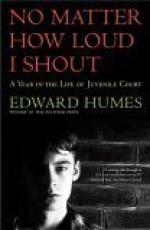|
This section contains 492 words (approx. 2 pages at 400 words per page) |

|
No Matter How Loud I Shout: A Year in the Life of Juvenile Court Summary & Study Guide Description
No Matter How Loud I Shout: A Year in the Life of Juvenile Court Summary & Study Guide includes comprehensive information and analysis to help you understand the book. This study guide contains the following sections:
This detailed literature summary also contains Topics for Discussion and a Free Quiz on No Matter How Loud I Shout: A Year in the Life of Juvenile Court by Edward Humes.
No Matter How Loud I Shout, written by Pulitzer-Prize winner Edward Humes, concerns the state of the juvenile justice system in the United States, specifically in LA County, in the mid-1990s. Humes served as a counselor and writing teacher for a number of juvenile delinquents, seven of whom he tracks throughout one year in the justice system in Los Angeles, Inglewood and Pomona California.
What is more striking about the book is not merely the difficult lives and troubles of the seven kids that Humes tracks but the terrible combination of institutional failure and neglect and public overreaction that makes nothing better for public safety, for victims and for perpetrators. Throughout the book, Humes documents failure after failure, illustrated by particular cases of failure.
Humes is most involved in the juvenile court of Judge Roosevelt Dorn, whose controversial ideas about how to run juvenile cases cause serious conflicts between his court, the district attorney's office and the public defender's department. Many juveniles are sent directly to adult court rather than being tried as juveniles. However, Dorn resists this policy, instead de facto bringing back "status offenses" which allows him to remove high-risk children from their homes and put them into delinquent camps, juvenile detention facilities and group homes. Dorn's methods, however, are erratic and lead him to be "exiled" to adult court for a year.
Peggy Beckstrand, the deputy district attorney, is also a major part of the story. She represents a harsher perspective, seeking to get justice for victims and often believing that certain children are irredeemable. While Beckstrand and Dorn often butt heads, her opposite philosophically is Sister Janet, who never gives up on any child, no matter how vicious and guilty. The book also focuses on probation officer, Sharon Stegall, who is responsible for one of the seven juveniles, Carla James.
Political controversy surrounds all of the policies in the juvenile justice system. In the conservative resurgence of the mid-nineties, a number of "get-tough" laws and regulations are passed in California that send a number of juveniles to adult court that didn't deserve it. However, the laws were prompted in part by another one of the juveniles, Ronald Duncan, a sociopath who brutally murdered two of his co-workers and showed no remorse.
Because he was nine days shy of sixteen, he could not be tried in adult court and would leave the juvenile justice system at twenty-five, free as any other citizen. Duncan's case is covered in detail and Beckstrand struggles to convict him. The book also occurs against the backdrop of a widely publicized study that showed that the juvenile justice system seems to have been wholly ineffectively.
The juvenile justice system seems to have treated the seven kids, Carla James, George Trevino, Ronald Duncan, Geri Vance, John Sloan, Andre and Elias Elizando, completely randomly. It saved three of them, failed to properly punish the one apparently nonredeemable kid, and failed the rest.
Read more from the Study Guide
|
This section contains 492 words (approx. 2 pages at 400 words per page) |

|



